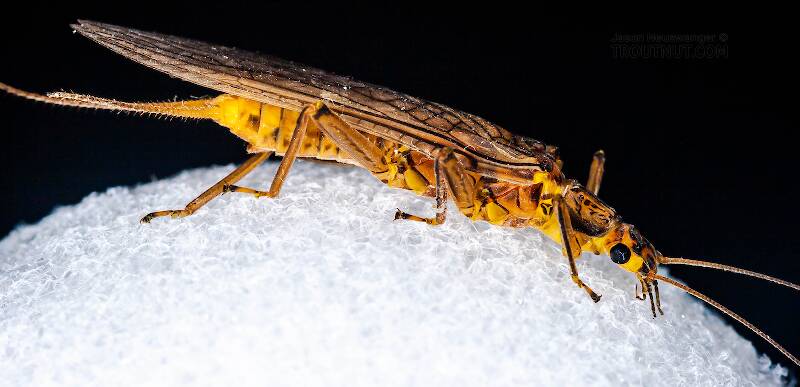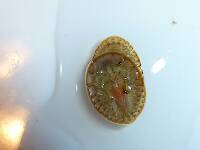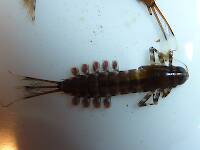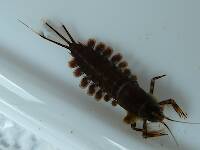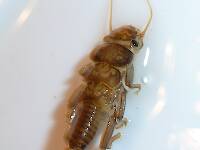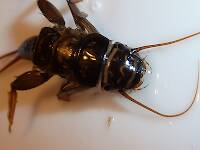
Hex Mayflies
Hexagenia limbata
The famous nocturnal Hex hatch of the Midwest (and a few other lucky locations) stirs to the surface mythically large brown trout that only touch streamers for the rest of the year.
Featured on the forum

Troutnut is a project started in 2003 by salmonid ecologist Jason "Troutnut" Neuswanger to help anglers and
fly tyers unabashedly embrace the entomological side of the sport. Learn more about Troutnut or
support the project for an enhanced experience here.
GONZO on Oct 28, 2008October 28th, 2008, 6:38 am EDT
This looks like Acroneuria, and the markings on the nymphal shuck seem to be a good match for carolinensis.
Entoman on Mar 11, 2012March 11th, 2012, 3:22 am EDT
The head markings are usually a little different on carolinensis. This looks to be a good match for lycorias. The contrasting bands of the husk were probably muted some when still encasing the nymph and are dark both at the apexes and basally as opposed to just at the apexes as most often seen with carolinensis. I also think I'm seeing the remnants of anal gills. This is a beautiful specimen! Most Acroneuria are much more somber.
BTW - the look of the ventral terminalia (subgenital plate & small 9th sternum) connote female.
A. lycorias
http://www.pbase.com/tmurray74/image/100463029
A. carolinensis
http://www.pbase.com/tmurray74/image/113177968
BTW - the look of the ventral terminalia (subgenital plate & small 9th sternum) connote female.
A. lycorias
http://www.pbase.com/tmurray74/image/100463029
A. carolinensis
http://www.pbase.com/tmurray74/image/113177968
"It's not that I find fishing so important, it's just that I find all other endeavors of Man equally unimportant... And not nearly as much fun!" Robert Traver, Anatomy of a Fisherman
PaulRoberts on Mar 16, 2012March 16th, 2012, 8:10 am EDT
I see a difference between the two that appears to be consistent in the images I've looked at, at least for larvae, and that is that abnormis' prothorax is more rectangular, while carolinensis is more oval -rounded, esp at the caudal (rearward) edges. Do you see this too?
I guess I'm not surprised to see the variations in coloration, although in the central NY waters I frequented, A. abnormis was usually a very dark brown critter with lemony underparts, compared to the brighter A. carolinensis.
Here are some ties I’d made back then for each:


I guess I'm not surprised to see the variations in coloration, although in the central NY waters I frequented, A. abnormis was usually a very dark brown critter with lemony underparts, compared to the brighter A. carolinensis.
Here are some ties I’d made back then for each:


Entoman on Mar 16, 2012March 16th, 2012, 10:41 am EDT
Great buggy looking designs, as usual for you Paul.
Now that you point it out, I do!
Its funny, but when working on species you don't have a lot of personal experience with , you have to resort heavily on the keys. Once you've done it enough you start to recognize other differences. A good analogy would be handing a key to somebody who's never seen elephants before. After looking at toenails and hair tail counts referenced in the key, the individual is able to determine which one is Indian and which one is African. After that telling them apart is easy!:)
Yes, you describe the common color schemes. While generally useful, there are enough variations that they aren't dependable for determinations.
Gonzo had an interesting comment a while back where he referenced a conversation he had with Dr. Chandler. He pointed out that in some watersheds the variabilities are so obscure among the three major species of nymphs that telling them apart may require association with male adults to identify with absolute certainty.
Generally, I've found the best way to tell the nymphs apart are the presence of the following characters:
abnormis - thin roughly parallel sided pale occipital bar with pale unattached thin commas near the ocelli or absent; broken or indistinct 'W' mark; legs either solid colored or with long dark longitudinal bars or streaks; terga w/ dark central bands, or solid dark; anal gills usually absent.
carolinensis - thicker tapered pale occipital bar with pale attached heavy triangular or rounded markings near ocelli; distinct 'W' mark; legs with pale bands or blotches; terga w/ dark apical bands or solid dark; anal gills usually absent.
lycorias - very similar to carolinensis but usually with a large dark spot intruding into the center of the pale occipital band making it appear very thin there, or if not, a very thick W mark; terga w/ dark bands both apically and basally or solid dark; anal gills usually present.
As Dr. Chandler pointed out, these characters are far from absolute, but I believe they are much more dependable than going by shade of dorsal habitus alone.
I see a difference between the two that appears to be consistent in the images I've looked at, at least for larvae, and that is that abnormis' prothorax is more rectangular, while carolinensis is more oval -rounded, esp at the caudal (rearward) edges. Do you see this too?
Now that you point it out, I do!
Its funny, but when working on species you don't have a lot of personal experience with , you have to resort heavily on the keys. Once you've done it enough you start to recognize other differences. A good analogy would be handing a key to somebody who's never seen elephants before. After looking at toenails and hair tail counts referenced in the key, the individual is able to determine which one is Indian and which one is African. After that telling them apart is easy!:)
I guess I'm not surprised to see the variations in coloration, although in the central NY waters I frequented, A. abnormis was usually a very dark brown critter with lemony underparts, compared to the brighter A. carolinensis.
Yes, you describe the common color schemes. While generally useful, there are enough variations that they aren't dependable for determinations.
Gonzo had an interesting comment a while back where he referenced a conversation he had with Dr. Chandler. He pointed out that in some watersheds the variabilities are so obscure among the three major species of nymphs that telling them apart may require association with male adults to identify with absolute certainty.
Generally, I've found the best way to tell the nymphs apart are the presence of the following characters:
abnormis - thin roughly parallel sided pale occipital bar with pale unattached thin commas near the ocelli or absent; broken or indistinct 'W' mark; legs either solid colored or with long dark longitudinal bars or streaks; terga w/ dark central bands, or solid dark; anal gills usually absent.
carolinensis - thicker tapered pale occipital bar with pale attached heavy triangular or rounded markings near ocelli; distinct 'W' mark; legs with pale bands or blotches; terga w/ dark apical bands or solid dark; anal gills usually absent.
lycorias - very similar to carolinensis but usually with a large dark spot intruding into the center of the pale occipital band making it appear very thin there, or if not, a very thick W mark; terga w/ dark bands both apically and basally or solid dark; anal gills usually present.
As Dr. Chandler pointed out, these characters are far from absolute, but I believe they are much more dependable than going by shade of dorsal habitus alone.
"It's not that I find fishing so important, it's just that I find all other endeavors of Man equally unimportant... And not nearly as much fun!" Robert Traver, Anatomy of a Fisherman
Feathers5
Posts: 287
Posts: 287
Feathers5 on Mar 19, 2012March 19th, 2012, 7:08 am EDT
Paul. You gotta come up with a step by step pattern tutorial for these stoneflies complete with photos for each step. They really look like great patterns. I have about 3 different stonefly patterns. I'm always looking for another good one and I think yours is one of them.
Bruce
Bruce
PaulRoberts on Mar 19, 2012March 19th, 2012, 7:21 am EDT
Entoman on Mar 19, 2012March 19th, 2012, 9:26 am EDT
Oops... I just noticed that after moving this specimen out of carolinensis I inadvertantly put it in with abnormis. While it's certainly possible to be the former, I think it's pretty safe to say it isn't the latter. :) Been doing a lot of editing lately and must have hit the wrong button. Sorry for any confusion this may have caused.
"It's not that I find fishing so important, it's just that I find all other endeavors of Man equally unimportant... And not nearly as much fun!" Robert Traver, Anatomy of a Fisherman
Quick Reply
Related Discussions
Topic
Replies
Last Reply
Acroneuria specimen moved from genus to species level
In Acroneuria carolinensis Stonefly Nymph by Entoman
In Acroneuria carolinensis Stonefly Nymph by Entoman
0
Mar 11, 2012
by Entoman
by Entoman
0
Apr 8, 2013
by Entoman
by Entoman
4
Mar 11, 2012
by Entoman
by Entoman
0
Jun 11, 2023
by Fishohio614
by Fishohio614



